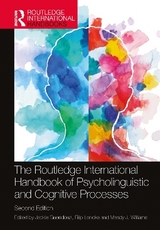
The Handbook of Psycholinguistic and Cognitive Processes
Psychology Press Ltd (Verlag)
978-1-84872-910-0 (ISBN)
This handbook includes an overview of those areas of cognition and language processing that are relevant to the field of communication disorders, and provides examples of theoretical approaches to problems and issues in communication disorders.
The first section includes a collection of chapters that outline some of the basic considerations and areas of cognition and language that underlie communication processing; a second section explains and exemplifies some of the influential theories of psycholinguistic/cognitive processing; and the third section illustrates theoretical applications to clinical populations.
There is coverage of theories that have been either seminal or controversial in the research of communication disorders. Given the increasing multi-cultural workload of many practitioners working with clinical populations, chapters relating to bilingual populations are also included.
The volume book provides a single interdisciplinary source where researchers and students can access information on psycholinguistic and cognitive processing theories relevant to clinical populations. A range of theories, models, and perspectives are provided. The range of topics and issues illustrate the relevance of a dynamic interaction between theoretical and applied work, and retains the complexity of psycholinguistic and cognitive theory for readers (both researchers and graduate students) whose primary interest is the field of communication disorders.
Jackie Guendouzi, Ph.D., is a Linguist who received her undergraduate and graduate degrees from Cardiff University (UK) and is currently an Associate Professor at Southeastern Louisiana University. Her research interests include language processing in clinical populations and pragmatics. Filip Loncke, Ph.D., is assistant professor at the University of Virginia. He has lectured, conducted research, and published in psycholinguistic processes involved in atypical communication and in their clinical applications. In 2003 and 2004 he was president of the International Society for Augmentative and Alternative Communication (ISAAC). Mandy J. Williams, Ph.D., CCC-SLP, is an Assistant Professor in the Department of Communication Disorders at the University of South Dakota. Her research focuses on children and adults with fluency disorders.
J. Guendouzi, F. Lonck, M.J. Williams, Introduction. Part 1. Some Basic Considerations: Models and Theories. J. Locke, The Development of Linguistic Systems: Insights from Evolution. N. Presson, B. MacWhinney, The Competition Model and Language Disorders. L. Abrams, M.T. Farrell, Language Processing in Normal Aging. N. Cowan, Working Memory and Attention in Language Use. K. Kahlaoui et al, Neurobiological bases of the Semantic Processing of Words. M. Kutas et al, From Phonemes to Discourse: Event-related brain potential (ERP) componentry and Paradigms for Investigating Normal and Abnormal Language Processing. M. Friedrich, Early word learning – Reflections on Behavior, Connectionist Models and Brain Mechanisms Indexed by ERP Components. G. Dell, A. Kittredge, Connectionist Models of Aphasia and Other Language Impairments. A. Roelofs, Modeling the Attentional Control of Vocal Utterance Production: From Wernicke to WEAVER++. J. Shelley-Tremblay, Theories of Semantic Processing. C.E. Longworth, W.D. Marslen-Wilson, Language comprehension: A Neurocognitive Approach. D. Van Lancker Sidtis, Formulaic Expressions in Mind and Brain: Empirical Studies and a Dual-Process Model of Language Competence. M. Yates, How Similarity Influences Word Recognition: The Effect of Neighbors. M. Tatham, K. Morton, Two Theories of Speech Production and Perception. B. Rutter, M.J. Ball, Psycholinguistic validity and the Phonological Representation. W. Zielger et al, From Phonology to Articulation. A Neurophonetic View. Part 2. Developmental Disorders. T. Shive, T.J. Bellis, (Central) Auditory Processing Disorders: Current Conceptualizations. M. Burns, Temporal Processing in Children with Language Impairment. B. Grela et al, Language Processing in Children with Specific-language Impairment. H. Van der Lely, C. Marshal, Grammatical-Specific-language Impairment: A Window onto Domain Specificity. H. Storkel, The Developing Mental Lexicon of Children with Specific-language Impairment. P. Howell, Language-speech Processing in Fluency Disorders. S. Armon-Lotem, J. Walters, An Approach to Differentiating Bilingualism and Language Impairment. B.M. Bernhardt et al, Nonlinear Phonology: Clinical Application Adaptations for Arabic, German and Mandarin. M.A. Restrepo et al, Bilingual children with SLI: Theories, Research and Future directions. Part 3. Acquired Disorders. R. Varley, Apraxia of Speech: From Psycholinguistic Theory to Conceptualization and Management of an Impairment. M. McNeil et al, The Role of Memory and Attention in the Language Performance of Persons with Aphasia. H. Brownel, K. Lundgren, Remediation of Theory of Mind Impairments in Brain-Injured Adults. L. Togher, Cognitive Communication Disorders after Traumatic Brain Injury. J. Shelley-Tremblay, Breakdown of Semantics in Aphasia and Alzheimer’s Dementia: A Role for Attention. J. Centeno, Understanding Language Recovery in Bilinguals with Aphasia: Neurolinguistic and Neurocognitive Considerations of Language Processing in Bilingual Individuals. Part 4. Language and Other Modalities. D. McNeill, S. Duncan, Gestures and Growth Points in Language. G. Hickok, U. Bellugi, Neural Organization of Language: Clues from Sign Language Aphasia. M. Vermeerbergen, M. Van Herreweghe, Sign Languages and Sign Language Research. J. Barnes, S. Baron-Cohen, Language in Autism: Pragmatics and Theory of Mind. N. Ryder, E. Leinonen, Relevance theory: Investigating Pragmatic Language Comprehension Difficulties in Children with SLI, Aspergers’ Syndrome and High Functioning Autism. F. Loncke, Psycho-linguistic Approaches to Augmentative and Alternative Communication. J. Guendouzi et al, Epilogue.
| Erscheint lt. Verlag | 8.10.2010 |
|---|---|
| Reihe/Serie | Routledge International Handbooks |
| Zusatzinfo | 11 Tables, black and white; 58 Illustrations, black and white |
| Verlagsort | Hove |
| Sprache | englisch |
| Maße | 156 x 234 mm |
| Gewicht | 1770 g |
| Themenwelt | Geisteswissenschaften ► Psychologie ► Allgemeine Psychologie |
| Geisteswissenschaften ► Psychologie ► Biopsychologie / Neurowissenschaften | |
| Geisteswissenschaften ► Psychologie ► Verhaltenstherapie | |
| Geisteswissenschaften ► Sprach- / Literaturwissenschaft ► Sprachwissenschaft | |
| ISBN-10 | 1-84872-910-3 / 1848729103 |
| ISBN-13 | 978-1-84872-910-0 / 9781848729100 |
| Zustand | Neuware |
| Haben Sie eine Frage zum Produkt? |
aus dem Bereich



